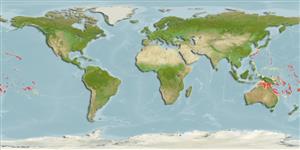Common names from other countries
>
Acanthuriformes (Surgeonfishes) >
Acanthuridae (Surgeonfishes, tangs, unicornfishes) > Nasinae
Etymology: Naso: Latin, nasus = nose (Ref. 45335); caesius: Naso caesius is in reference to its most common ground color which is bluish grey..
More on authors: Randall & Bell.
Environment: milieu / climate zone / depth range / distribution range
Ecologia
marinhas associadas(os) a recifes; intervalo de profundidade 15 - 50 m (Ref. 90102). Tropical
Pacific Ocean: Northern Marianas, Marshall Islands, Hawaiian Islands, Pitcairn group, Society Islands (French Polynesia), Australia and New Caledonia.
Tamanho / Peso / Idade
Maturity: Lm ? range ? - ? cm
Max length : 45.6 cm SL macho/indeterminado; (Ref. 9944)
Espinhos dorsais (total) : 6 - 7; Raios dorsais moles (total) : 27 - 30; Espinhos anais: 2; Raios anais moles: 28 - 31. Bluish grey to grey-brown, capable of displaying a colour pattern of vertically elongate blotches (lighter or darker than ground colour) on side and upper part of body. Opercular and preopercular margins not dark brown. Caudal fin uniform in colour. Gill rakers on lower limb of gill arches entirely pale. Edge of lower lip not white (Ref 9808).
Benthopelagic over coral and rock (Ref. 58302). Occurs singly or in aggregations along clear seaward and outer lagoon reefs and channels (Ref. 37816). Feeds in midwater on zooplankton (Ref. 90102).
Life cycle and mating behavior
Maturities | Reprodução | Spawnings | Egg(s) | Fecundities | Larvas
Randall, J.E. and L.J. Bell, 1992. Naso caesius, a new acanthurid fish from the Central Pacific. Pac. Sci. 46(3):344-352. (Ref. 9944)
Categoria na Lista Vermelha da IUCN (Ref. 130435)
CITES (Ref. 128078)
Not Evaluated
Ameaça para o homem
Harmless
Utilização humana
Pescarias: espécies comerciais
Ferramentas
Relatórios especiais
Descarregue XML
Fontes da internet
Estimates based on models
Preferred temperature (Ref.
115969): 24.7 - 28.8, mean 26.5 (based on 82 cells).
Phylogenetic diversity index (Ref.
82804): PD
50 = 0.5000 [Uniqueness, from 0.5 = low to 2.0 = high].
Bayesian length-weight: a=0.01995 (0.00906 - 0.04395), b=3.00 (2.82 - 3.18), in cm Total Length, based on LWR estimates for this Genus-body shape (Ref.
93245).
Nível Trófico (Ref.
69278): 2.3 ±0.1 se; based on size and trophs of closest relatives
Resiliência (Ref.
120179): Médio, tempo mínimo de duplicação da população 1,4 - 4,4 anos (Preliminary K or Fecundity.).
Fishing Vulnerability (Ref.
59153): Moderate vulnerability (42 of 100).
